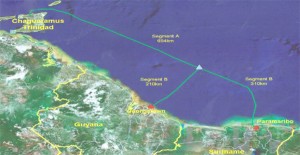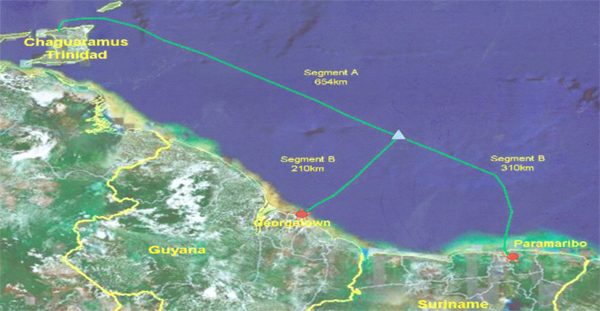– to see improved telecom services in 2010
The Guyana Telephone and Telegraph Company (GT&T) and the Telecommuni-catiebedrijf Suriname (Tele-sur) yesterday inked a US$60 million deal for a Suriname-Guyana Submarine Cable System (SG-SCS) that promises to deliver improved telecom services and to foster growth opportunities in both countries starting in 2010.

GT&T CEO Major General (ret’d) Joe Singh and Telesur Managing Director Dirk Currie signed a construction and maintenance agreement for the SG-SCS at a ceremony at the Royal Torarica Hotel in Paramaribo, while the two companies also signed a supply pact with contractor Global Marine Systems Ltd. With the new system, the two companies are promising reliable voice and data telecom services, including increased bandwidth, while emphasising the potential growth opportunities for their respective national economies. “It must be utilised as an instrument that can be a stimulus for development and that can facilitate the rapid transformation of our economies and our societies,” Singh said.
The SG-SCS will see the two countries linked through a state-of-the-art 1,200 kilometre (700 mile) submarine fibre optic cable connected to a worldwide network of similar cables through a landing station in Trinidad. The cable will be routed from Chaguaramus, Trinidad to a branching unit in the Atlantic from where it will be diverted to Georgetown in Guyana and Paramaribo in Suriname. The integrated cable system will have the potential capacity of increasing the telecommunications bandwidth by 3,000 to 4,000 times more than what is currently available through the Americas 11 cable and satellite links. It is to become operational by the first quarter of 2010. A Memorandum of Understanding (MOU) was signed between the two companies on October 31, 2008 for the establishment of a framework of organisation to be effective prior to the construction and maintenance agreement. The agreement sets out the terms and conditions for the engineering, construction, operation, maintenance and restoration of the SG-SCS.
Currently, the capacity of the Americas 11 cable has almost been fully exploited, although it is due to be upgraded in 2010. There have been major disruptions in telecoms traffic here as a result of damage to the Americas 111 cable and the companies promise greater security and reliability with the new system.
Singh explained that although the Americas 11 cable and satellite links have served Guyana and Suriname well over the last decade, the SG-SCS will ensure sufficient capacity to more than cover all foreseeable transmission requirements. He added that the cable will provide a more secure redundancy to the current links, “virtually eliminating” the possibility of international communications outage to residential and business users.
The system is also expected to result in improved communications with neighbouring countries, like Brazil and French Guiana, which could potentially invest in terrestrial extensions to the new cable.
Singh disclosed that another “spin-off” of the new cable is that Brazil is “very interested” in a possible link-up since Amazonas and Roraima currently depend largely on satellite communication. “Brazil recognizes the particular advantages of those states having a cable link to our cable station here since the cable will also have the capacity to provide bandwidth for those two states.”
Singh explained that once the cable is landed, it is anticipated there would be great interest on the part of Brazil, and he referred specifically to the states of Amazonas and Roraima that are currently dependent on satellite communication. He said the state administrations are “very much interested” in a fibre optic cable link though he added that the modalities and details would have to be negotiated. With the extensive bandwidth that the system will provide, he said Guyana would have access to more than it would ever be able to use and therefore terrestrial links would be ideal to exploit the available capacity.
When asked about telecom competitors accessing the system and the possibility of lower bandwidth rates, Singh said that upon completion of the cable, the bandwidth will be available to all licensed operators in Guyana and Suriname and costs will be influenced by the rate of returns on the investment. He added that the volume of bandwidth available will also influence the rates, saying that the more people who buy in the lower the rates will be. Currie also said the bandwidth capacity could also be used by all parties, including competitors.
But he cautioned against viewing the SG-SCS as an upgrade for voice and data transmission services. Noting that in today’s knowledge-based global economy where capital and technology are increasingly mobile, Singh told stakeholders at the signing that the quality of a country’s information infrastructure will help to determine whether they attract investment. GT&T and its parent company ATN view the SG-SCS as part of their continuing commitment to Guyana and Singh reminded that before the privatisation of the telecoms sector, Guyana’s only link to outside world was through an unreliable, slow speed, tropospheric scatter system and then only to Trinidad. “With this investment, both Guyana and Suriname will be on equal footing with the most developed countries in terms of infrastructure, of their telecommunications connectivity, providing unlimited and secure bandwidth for business operations.
Singh recalled that during the recent commissioning of the Berbice Bridge, Guyana’s President Bharrat Jagdeo reiterated the need for upgrading of communications technology, repeating his familiar mantra that modern communications are a critical component for the country’s future growth. In this regard, he said developments would require time and partnerships between local and central government, ICT infrastructure service providers and other development agencies. He said GT&T is looking forward to partnering in identifying and participating in ways to exploit the ICT infrastructure for the benefit of the citizenry, citing e-governance as one such avenue. Singh said e-governance could improve the quality of government services through the creation of a nationwide system to deliver government services electronically, like pensions, passports and birth certificates. The development of an integrated electronic access to government information and services, the establishment of national law enforcement, public safety and civil defence networks were also cited as potential ways to improve the quality of government services.
Singh noted that a better ICT infrastructure has the potential to make the country work more efficiently, effectively and innovatively, particularly in a highly competitive global environment. He said it could also ensure that the country is guided by an informed population, produce high quality jobs and educated citizens to fill them, aid poverty reduction and provide continuous learning and distance education, health and business applications. “We are not naive to believe that ICT is either a magic silver bullet or an alternative to other development investments…” he, however, said. “…But of applied in conjunction with other initiatives, they are a crucial enabling factor for development.”
Meanwhile, in a statement the Office of the President (OP) said last evening that President Bharrat Jagdeo welcomed the signing of the deal. It noted that the agreement represents a significant event in the recent efforts by the parties to establish the new cable and it is hoped that it will be operationalised at the earliest possible time.
OP also said that government expects that the new fibre optic cable will provide adequate redundancy for the current telecom systems, thereby significantly improving the reliability and quality of current systems and services. Moreover, the new cable is expected to provide new capacity for telecommunications traffic and to positively impact the cost and adequacy of bandwidth for telecommunications and ICT applications. “The new cable will positively impact the growth and development of the telecommunications sector in Guyana and will consequently influence the expansion and development of our economic and social wellbeing,” OP added.
Singh was accompanied to the signing by GT&T Deputy General Manager Terry Holder, Director of Systems Engineering Russell Davis and Director of Business Planning Eustace Abrams.

